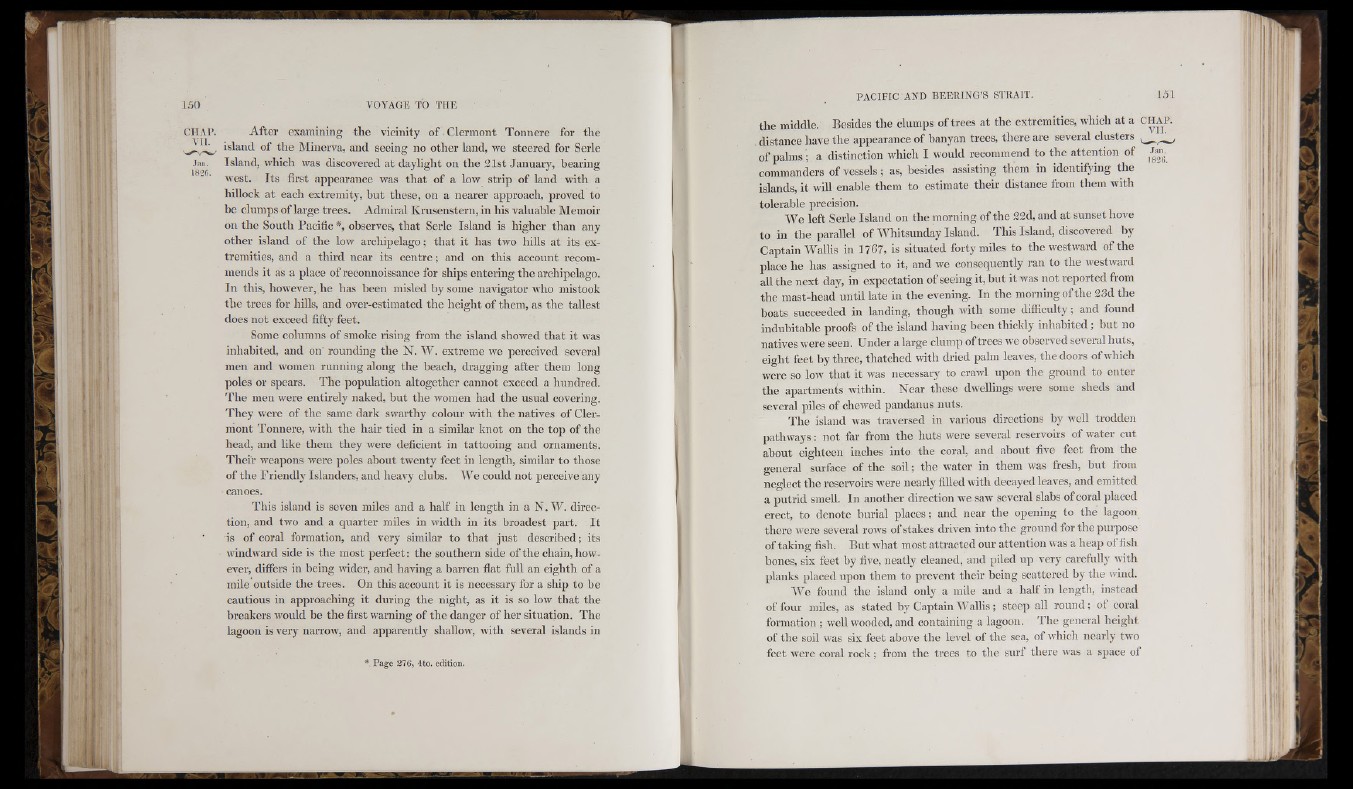
After examining the vicinity of Clermont Tonnere for the
island of the Minerva, and seeing no other land, we steered for Serle
Island, which was discovered at daylight on the 21st Jannary, bearing
west. Its first appearance was that of a low strip of land with a
hillock at each extremity, hnt these, on a nearer approach, proved to
be chimps of large trees. Admiral Krusenstern, in his valuable Memoir
on the South Pacific *, observes, that Serle Island is higher than any
other island of the low archipelago; that it has two hills at its extremities,
and a third near its centre; and on this account recommends
it as a place of reconnoissance for ships entering the archipelago.
In this, however, he has been misled by some navigator who mistook
the trees for hills, and over-estimated the height of them, as the tallest
does not exceed fifty feet.
Some columns of smoke rising from the island showed that it was
inhabited, and on' rounding the N . YY". extreme we perceived several
men and women running along the beach, dragging after them long
poles or spears. The population altogether cannot exceed a hundred.
The men were entirely naked, but the women had the usual covering.
They were of the same dark swarthy colour with the natives of Clermont
Tonnere, with the hair tied in a similar knot on the top of the
head, and like them they were deficient in tattooing and ornaments.
Their weapons were poles about twenty feet iu length, similar to those
of the Friendly Islanders, and heavy clubs. YY"e could not perceive any
canoes.
This island is seven miles and a half in length in a N.YY". direction,
and two and a quarter miles in width in its broadest part. It
is of coral formation, and very similar to that just described; its
windward side is the most perfect: the southern side of the chain, however,
differs in being wider, and having a barren flat full an eighth of a
mile outside the trees. On this account it is necessary for a ship to be
cautious in approaching it during the night, as it is so low that the
breakers would be the first warning of the danger of her situation. The
lagoon is very narrow, and apparently shallow, with several islands in
* P ag e 276, Fto. edition.
the middle. Besides the clumps of trees at the extremities, which at a C H A P .
distance have the appearance of banyan trees, there are several clusters
of palms ; a distinction which I would recommend to the attention of
Jan.
1826.
commanders of vessels ; as, besides assisting them in identifying the
islands, it will enable them to estimate their distance from them with
tolerable precision.
YY"e left Serle Island on the morning of the 22d, and at sunset hove
to in the parallel of YY"hitsunday Island. This Island, discovered by
Captain YVallis in 1767, is situated forty miles to the westward of the
place he has assigned to it, and we consequently ran to the westward
all the next day, in expectation of seeing it, but it was not reported from
the mast-head until late in the evening. In the morning of the 2Sd the
boats succeeded in landing, though with some difficulty ; and found
indubitable proofs of the island having been thickly inhabited ; but no
natives were seen. Under a large clump of trees wc observed several huts,
eight feet by three, thatched with dried palm leaves, the doors of wliieh
were so low that it was necessary to crawl upon the ground to enter
the apartments within. Near these dw’ellings were some sheds and
several piles of chewed pandanus nuts.
The island was traversed in various directions by well trodden
pathways : not far from the huts were several reservoirs of w ater cut
about eighteen inches into the coral, and about five feet from the
general surface of the soil ; the w'ater in them w*as fresh, but from
neglect the reservoirs were nearly filled w’ith decayed leaves, and emitted
a putrid smell. In another direction w*e saw several slabs of coral placed
erect, to denote burial places ; and near the opening to the lagoon
there w ere several rows of stakes driven into the ground for the purpose
of taking fish. But what most attracted our attention was a heap of fish
hones, six feet by five, neatly cleaned, and piled up very carefully with
planks placed upon them to prevent their being scattered by the wind.
We found the island only a mile and a half in length, instead
of four miles, as stated by Captain Wallis ; steep all round; of coral
formation ; w^ell w'ooded, and containing a lagoon. The general height
of the soil was six feet above the level of the sea, of wliich nearly two
feet were coral rock ; from the trees to the surf there was a space of